Starbucks
Starbucks Corporation is an American multinational chain of coffeehouses and roastery reserves headquartered in Seattle, Washington. As the world's largest coffeehouse chain, Starbucks is seen to be the main representation of the United States' second wave of coffee culture.[6][7] As of early 2020, the company operates over 30,000 locations worldwide in more than 70 countries. Starbucks locations serve hot and cold drinks, whole-bean coffee, microground instant coffee known as VIA, espresso, caffe latte, full- and loose-leaf teas including Teavana tea products, Evolution Fresh juices, Frappuccino beverages, La Boulange pastries, and snacks including items such as chips and crackers; some offerings (including their annual fall launch of the Pumpkin Spice Latte) are seasonal or specific to the locality of the store.
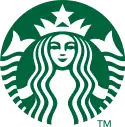 Logo used since 2011 | |
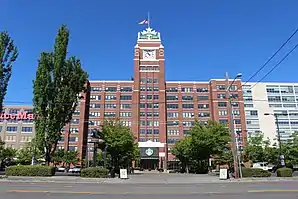 Starbucks headquarters at Starbucks Center in Seattle, Washington | |
| Type | Public |
|---|---|
| Industry | Coffee shop |
| Founded | March 30, 1971 Pike Place Market, Elliott Bay, Seattle, Washington, U.S. |
| Founders | |
| Headquarters | 2401 Utah Avenue South, Seattle, Washington |
Number of locations | 31,256 (2019) |
Area served | Worldwide |
Key people |
|
| Products |
|
| Revenue | |
| Total assets | |
| Total equity | |
Number of employees | 346,000 (2019) |
| Subsidiaries | |
| Website | Starbucks.com |
| Footnotes / references [1][2][3][4][5] | |
Headquartered in the Starbucks Center, the company was founded in 1971 by Jerry Baldwin, Zev Siegl, and Gordon Bowker at Seattle's Pike Place Market. During the early 1980s, they sold the company to Howard Schultz who – after a business trip to Milan, Italy – decided to make the coffee bean store a coffeeshop serving espresso-based drinks. Schultz's first tenure as chief executive, from 1986 to 2000, led to an aggressive expansion of the franchise, first in Seattle, then across the U.S. West Coast. Despite an initial economic downturn with its expansion into the Midwest and British Columbia, the company experienced revitalized prosperity with its entry into California in the early 1990s through a series of highly publicized coffee wars. Schultz was succeeded by Orin Smith who ran the company for five years, positioning Starbucks as a large player in fair trade coffee and increasing sales to $5 billion. Jim Donald served as chief executive from 2005 to 2008, orchestrating a large-scale earnings expansion. Schultz returned as CEO in the middle of the 2008 financial crisis and spent the succeeding decade growing its market share, expanding its offerings, and reorienting itself around corporate social responsibility. Kevin Johnson took over from Schultz in 2017, and continues to serve as the firm's chief executive.
Many stores sell pre-packaged food items, pastries, hot and cold sandwiches, and drinkware including mugs and tumblers. There are also several select "Starbucks Evenings" locations which offer beer, wine, and appetizers. Starbucks-brand coffee, ice cream, and bottled cold coffee drinks are also sold at grocery stores in the United States and other countries. In 2010, the company began its Starbucks Reserve program for single-origin coffees and high-end coffee shops. It planned to open 1,000 Reserve coffee shops by the end of 2017.[8] Starbucks operates six roasteries with tasting rooms and 43 coffee bars as part of the program. The latest roastery location opened on Chicago's Magnificent Mile in November 2019, and is the world's largest Starbucks. The company has received significant and sustained criticism about its business practices, corporate affairs, and role in society. Conversely, its franchise has commanded substantial brand loyalty, market share, and company value.
History
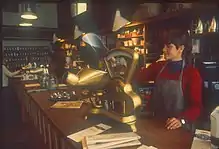
Founding
The first Starbucks was opened in Seattle, Washington, on March 30, 1971,[9] by three partners who met while they were students at the University of San Francisco:[10] English teacher Jerry Baldwin, history teacher Zev Siegl, and writer Gordon Bowker were inspired to sell high-quality coffee beans and equipment by coffee roasting entrepreneur Alfred Peet after he taught them his style of roasting beans.[11] Bowker recalls that Terry Heckler, with whom Bowker owned an advertising agency, thought words beginning with "st" were powerful. The founders brainstormed a list of words beginning with "st," and eventually landed on "Starbo," a mining town in the Cascade Range. From there, the group remembered "Starbuck," the name of the chief mate in the book Moby-Dick.[12] Bowker said, "Moby-Dick didn't have anything to do with Starbucks directly; it was only coincidental that the sound seemed to make sense."[12][13]
The first Starbucks store was located in Seattle at 2000 Western Avenue from 1971 to 1976. This cafe was later moved to 1912 Pike Place.[14] During this time, the company only sold roasted whole coffee beans and did not yet brew coffee to sell.[15] During their first year of operation, they purchased green coffee beans from Peet's,[16] then began buying directly from growers.
Sale and expansion
.jpg.webp)
In 1984, the original owners of Starbucks, led by Jerry Baldwin, purchased Peet's Coffee.[17] By 1986, the company operated six stores in Seattle[18] and had only just begun to sell espresso coffee.[19] In 1987, the original owners sold the Starbucks chain to former manager Howard Schultz, who rebranded his Il Giornale coffee outlets as Starbucks and quickly began to expand the company.[20] That same year, Starbucks opened its first locations outside of Seattle in Waterfront Station in Vancouver, British Columbia, and Chicago, Illinois.[21] By 1989, 46 Starbucks stores existed across the Northwest and Midwest, and the company was roasting more than 2,000,000 pounds (907,185 kg) of coffee annually.[18] At the time of its initial public offering (IPO) on the stock market in June 1992, Starbucks had 140 outlets, with revenue of US$73.5 million, up from US$1.3 million in 1987. The company's market value was US$271 million by this time.[22] The 12% portion of the company that was sold raised around US$25 million for the company, which enabled it to double its number of stores over the next two years.[23] By September 1992, Starbucks's share price had risen by 70% to more than 100 times the earnings per share of the previous year.[15] In July 2013, more than 10% of in-store purchases were made on customers' mobile devices via the Starbucks app.[24]
The company once again utilized the mobile platform when it launched the "Tweet-a-Coffee" promotion in October 2013. On this occasion, the promotion also involved Twitter and customers were able to purchase a US$5 gift card for a friend by entering both "@tweetacoffee" and the friend's handle in a tweet. Research firm Keyhole monitored the progress of the campaign; a December 2013 media article reported that 27,000 people had participated and US$180,000 of purchases had been made to date.[25][26] As of 2018, Starbucks is ranked 132nd on the Fortune 500 list of the largest United States corporations by revenue.[27] In July 2019, Starbucks reported "fiscal third-quarter net income of $1.37 billion, or $1.12 per share, up from $852.5 million, or 61 cents per share, a year earlier." The company's market value of $110.2 billion increased by 41% in mid-2019. The earnings per share in quarter three were recorded at 78 cents, much more than the forecast of 72 cents.[28] The sales in 2020 influenced by COVID-19 and Starbucks reported 38% declined in revenue from the same period in the prior year to $4.2 billion during the quarter ended June 28 in the Americas region.[29] In December 2020, Starbucks announced that it is planning to increase its store count to about 55,000 by 2030, up from roughly 33,000.[30]
| Year | Revenue in mil. US$ |
Net income in mil. US$ |
Total Assets in mil. US$ |
Average Price per Share in US$ |
Employees |
|---|---|---|---|---|---|
| 2005 | 6,369 | 494 | 3,514 | 13.40 | 115,000 |
| 2006 | 7,787 | 564 | 4,429 | 17.62 | 145,800 |
| 2007 | 9,412 | 673 | 5,344 | 14.12 | 172,000 |
| 2008 | 10,383 | 316 | 5,673 | 7.61 | 176,000 |
| 2009 | 9,775 | 391 | 5,577 | 7.87 | 142,000 |
| 2010 | 10,707 | 946 | 6,386 | 13.07 | 137,000 |
| 2011 | 11,700 | 1,246 | 7,360 | 18.92 | 149,000 |
| 2012 | 13,277 | 1,384 | 8,219 | 25.63 | 160,000 |
| 2013 | 14,867 | 8 | 11,517 | 33.71 | 182,000 |
| 2014 | 16,448 | 2,068 | 10,753 | 37.78 | 191,000 |
| 2015 | 19,163 | 2,757 | 12,416 | 53.25 | 238,000 |
| 2016 | 21,316 | 2,818 | 14,313 | 56.59 | 254,000 |
| 2017 | 22,387 | 2,885 | 14,366 | 57.27 | 277,000 |
| 2018 | 24,720 | 4,518 | 24,156 | 57.50 | 291,000 |
| 2019 | 26,509 | 3,599 | 19,220 | 81.44 | 346,000 |
| 2020 | 23,518 | 928 | 29,375 | 82.33 | 349,000 |
Expansion to new markets and products
.jpg.webp)
The first Starbucks location to open outside of North America opened in Tokyo, Japan, in July 1996.[32] On December 4, 1997, the Philippines became the third market to open outside of North America.[33][34] Starbucks entered the U.K. market in 1998 with the US$83 million[35] acquisition of the then 56-outlet, UK-based Seattle Coffee Company, re-branding all those stores as Starbucks.[35] In 1999, Starbucks experimented with eateries in the San Francisco Bay area through a restaurant chain called Circadia.[36] After people learned that these restaurants were owned by Starbucks, Starbucks converted the restaurants to Starbucks cafes.[37] Australia's first Starbucks store opened in July 2000 in Sydney.[38] After a massive downturn in 2008, the remaining Australian Starbucks stores were purchased in 2014, with the company planning a more restrained expansion.[39][40] In September 2002, Starbucks opened its first store in Latin America, in Mexico City.[41] Currently, there are more than 500 locations in Mexico.[42] In October 2002, Starbucks established a coffee trading company in Lausanne, Switzerland to handle purchases of green coffee.[43] All other coffee-related business continued to be managed from Seattle.[44]
In April 2003, Starbucks completed the purchase of Seattle's Best Coffee and Torrefazione Italia from AFC Enterprises for $72m. The deal only gained 150 stores for Starbucks, but according to the Seattle Post-Intelligencer, the wholesale business was more significant.[45] In September 2006, rival Diedrich Coffee announced that it would sell most of its company-owned retail stores to Starbucks, escalating a regional coffee war. This sale included the company-owned locations of the Oregon-based Coffee People chain. Starbucks converted the Diedrich Coffee and Coffee People locations to Starbucks, although the Portland International Airport Coffee People locations were excluded from the sale.[46]
In August 2003, Starbucks opened its first store in South America in Lima, Peru.[47] The company opened its first store in Russia in 2007, ten years after first registering a trademark there.[48] In 2008, Starbucks purchased the manufacturer of the Clover Brewing System. They began testing the "fresh-pressed" coffee system at several Starbucks locations in Seattle, California, New York, and Boston.[49]
In early 2008, Starbucks started a community website, My Starbucks Idea, designed to collect suggestions and feedback from customers. Other users comment and vote on suggestions. Journalist Jack Schofield noted that "My Starbucks seems to be all sweetness and light at the moment, which I don't think is possible without quite a lot of censorship."[50] In May 2008, a loyalty program was introduced for registered users of the Starbucks Card (previously simply a gift card) offering perks such as free Wi-Fi Internet access, no charge for soy milk and flavored syrups, and free refills on brewed drip coffee, iced coffee, or tea.[51] In 2009, Starbucks began beta testing its mobile app for the Starbucks card, a stored value system in which consumers access pre-paid funds to purchase products at Starbucks.[52] Starbucks released its complete mobile platform on January 11, 2011.
On November 14, 2012, Starbucks announced the purchase of Teavana for US$620 million in cash;[53] the deal was formally closed on December 31, 2012.[54]
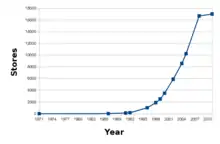
On February 1, 2013, Starbucks opened its first store in Ho Chi Minh City, Vietnam,[55][56][57] and this was followed by an announcement in late August 2013 that the retailer would be opening its inaugural store in Colombia. The Colombian announcement was delivered at a press conference in Bogota, where the company's CEO explained, "Starbucks has always admired and respected Colombia's distinguished coffee tradition."[58] In May 2014, the Starbucks operations in South Korea launched a mobile ordering system named Siren Order, which is accessible through a local version of Starbucks smartphone application.[59][60] In the U.S. Starbucks later launched a similar system named Mobile Order & Pay, which launched in Portland, Oregon in December 2015.[61] The service has since expanded nationwide, and in late March 2018, the company opened the system (previously available to Starbucks Rewards members only) to all customers.[62][63] In August 2014, Starbucks opened their first store in Williamsburg, Brooklyn, one of 30 Starbucks stores to offer beer and wine.[64]
In September 2014, it was revealed that Starbucks would acquire the remaining 60.5 percent stake in Starbuck Coffee Japan that it does not already own, at a price of $913.5 million.[65] In August 2015, Starbucks announced its intention to enter Cambodia, its 16th market in the China/Asia Pacific region. The first location was scheduled to open in the capital city of Phnom Penh by the end of 2015.[66]
In February 2016, Starbucks announced that it would enter Italy, its 24th market in Europe, with the first location to open in Milan by 2018.[67] In August, startup company FluxPort introduced Qi inductive charging pads at select locations in Germany.[68][69][70] In September 2016, Starbucks announced a debut of its first-ever original content series called "Upstanders," which aimed to inspire Americans with stories of compassion, citizenship, and civility.[71] The series featured podcasts, written word, and video, and was distributed via the Starbucks mobile app, online, and through the company's in-store digital network.[72] On July 27, 2017, Starbucks acquired the remaining 50% stake in its Chinese venture from long-term joint venture partners Uni-President Enterprises Corporation (UPEC) and President Chain Store Corporation (PCSC).[73]
On March 21, 2018, Starbucks announced that it was considering the use of blockchain technology with an idea to connect coffee drinkers with coffee farmers who eventually can take advantage of new financial opportunities. The pilot program was planned to start with farmers in Costa Rica, Colombia and Rwanda, in order to develop a new way to track the bean to cup journey.[74] On June 19, 2018, Starbucks announced the closing of 150 locations in 2019; three times the number the corporation typically closes in a single year. The closings were to happen in urban areas that already have dense clusters of stores.[75] In 2018, Starbucks expanded its partnership with Uber Eats to bring its beverages to U.S. customers' doorsteps, as it had already done for some time in China.[76] In November 2019, Starbucks opened its largest store ever on Michigan Avenue, Chicago. The store is open seven days a week and has 200 employees.[77]
COVID-19 pandemic response
On March 20, 2020, due to the COVID-19 pandemic, Starbucks decided to close all the cafe-only stores in the United States for two weeks. During that time, only drive-thru and delivery-only were to function. According to the company representatives, all workers were to be paid for the next 30 days whether they went to work or stayed home.[78] COVID-19 lockdowns caused Starbucks to suffer a general 10% sales decrease, and a 50% decrease in China where quarantine measures were especially strict.[79]
According to the business website, "Marker" their coffee sales will not recover to pre-COVID-19 pandemic levels until 2024. The analysts estimated Starbucks will owe $1.25 billion in rent over the next year at its 16,000 company-controlled stores. The company asked for reduced rent from landlords in May 2020 due to the decrease in sales. As of early 2020, Starbucks controlled about 40 percent of the United States coffee market.[80] In November 2020, Starbucks announced that it plans to open an outlet in Laos as it expands its network of more than 10.000 stores in Asian countries. Starbucks said it was monitoring the coronavirus situation but is still aiming at an opening in summer 2021.[81]
Corporate governance
Kevin Johnson, who served as president and chief operating officer from 2015 to 2018, has been the chief executive of Starbucks since April 2017.[82] Myron Ullman became the firm's chairman in June 2018.[83] Both Johnson and Ullman succeeded Howard Schultz, who served in both capacities from 2008 to 2017.[84] Orin Smith was president and CEO of Starbucks from 2001 to 2005, after which Jim Donald took over as CEO until 2008.[85] Since 2018, Schultz has served as the firm's first Chairman emeritus.[86]
Analysts have long believed that the firm's corporate governance must determine how to contend with higher materials prices and enhanced competition from lower-priced fast-food chains, including McDonald's and Dunkin' Donuts. In October 2015, Starbucks hired its first chief technology officer, Gerri Martin-Flickinger, to lead its technology team.[87] Starbucks maintains control of production processes by communicating with farmers to secure beans, roasting its own beans, and managing distribution to all retail locations. Additionally, Starbucks's Coffee and Farmer Equity Practices require suppliers to inform Starbucks what portion of wholesale prices paid reaches farmers.[88][89]
Board of directors
As of October 2020:[90]
- Howard Schultz, chairman emeritus
- Myron E. Ullman, chairman, former chairman and CEO of J.C. Penney
- Mellody Hobson, president and co-CEO of Ariel Investments
- Richard Allison, CEO of Domino's Pizza
- Rosalind Brewer, COO of Starbucks
- Andrew Campion, COO of Nike
- Mary Dillon, CEO of Ulta
- Isabel Ge Mahe, executive at Apple
- Kevin Johnson, president and CEO of Starbucks
- Jørgen Vig Knudstorp, former chairman and CEO of LEGO Group
- Satya Nadella, CEO of Microsoft
- Joshua Cooper Ramo, vice chairman and co-CEO of Kissinger Associates
- Clara Shih, CEO and co-founder of Hearsay Social
- Javier Teruel, former vice-chairman of Colgate-Palmolive
Products
.jpg.webp)
In 1994, Starbucks bought The Coffee Connection, gaining the rights to use, make, market, and sell the "Frappuccino" beverage.[91] The beverage was introduced under the Starbucks name in 1995 and as of 2012, Starbucks had annual Frappuccinos sales of over $2 billion.[91] The company began a "skinny" line of drinks in 2008, offering lower-calorie and sugar-free versions of the company's offered drinks that use skim milk, and can be sweetened by a choice of natural sweeteners (such as raw sugar, agave syrup, or honey), artificial sweeteners (such as Sweet'N Low, Splenda, Equal), or one of the company's sugar-free syrup flavors.[92][93] Starbucks stopped using milk originating from rBGH-treated cows in 2007. In June 2009, the company overhauled its menu and began to sell salads and baked goods without high fructose corn syrup or artificial ingredients.[94] This move was expected to attract health- and cost-conscious consumers and will not affect prices.[94]
Starbucks introduced a new line of instant coffee packets, called VIA "Ready Brew," in March 2009. It was first unveiled in New York City with subsequent testing of the product also in Seattle, Chicago, and London. The first two VIA flavors include Italian Roast and Colombia, which were then rolled out in October 2009, across the U.S. and Canada with Starbucks stores promoting the product with a blind "taste challenge" of the instant versus fresh roast, in which many people could not tell the difference between the instant and freshly brewed coffee. Financial analysts speculated that by introducing instant coffee, Starbucks would devalue its own brand.[95] Starbucks began selling beer and wine at some US stores in 2010.[96] In 2011, Starbucks introduced its largest cup size, the Trenta, which can hold 31 US fluid ounces (920 ml).[97] In September 2012, Starbucks announced the Verismo, a consumer-grade single-serve coffee machine that uses sealed plastic cups of coffee grounds, and a "milk pod" for lattes.[98] On November 10, 2011, Starbucks Corporation announced that it had bought juice company Evolution Fresh for $30 million in cash and planned to start a chain of juice bars starting in around the middle of 2012, venturing into territory staked out by Jamba Inc. Its first store released in San Bernardino, California and plans for a store in San Francisco were to be launched in early 2013.[99]
In 2012, Starbucks began selling a line of iced Starbucks Refresher beverages that contain an extract from green arabica coffee beans. The beverages are fruit flavored and contain caffeine but advertised as having no coffee flavor. Starbucks's green coffee extraction process involves soaking the beans in water.[100] On June 25, 2013, Starbucks began to post calorie counts on menus for drinks and pastries in all of their U.S. stores.[101] In 2014, Starbucks began producing their own line of sodas, dubbed "Fizzio."[102] In 2015, Starbucks began serving coconut milk as an alternative to dairy and soy.[103] In March 2017, Starbucks announced the launch of two new limited-edition specialty drinks made from beans aged in whiskey barrels at its Seattle roastery.[104] Starbucks's barrel-aged coffee will be sold with a small batch of unroasted Starbucks Reserve Sulawesi beans, which are then hand-scooped into whiskey barrels from Washington state.[105]
| Name | Measurement | Notes |
|---|---|---|
| Short | 8 US fl oz (240 ml) | Smaller of the two original sizes |
| Tall | 12 US fl oz (350 ml) | Larger of the two original sizes |
| Grande | 16 US fl oz (470 ml) | Italian for "large" |
| Venti | 20 US fl oz (590 ml) - Hot 26 US fl oz (770 mL) - Iced |
Italian for "twenty" |
| Trenta | 30 US fl oz (890 ml) | Italian for "thirty" |
Tea
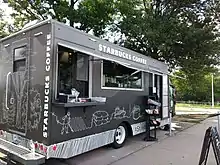
Starbucks entered the tea business in 1999 when it acquired the Tazo brand for US$8,100,000.[106][107] In late 2012, Starbucks paid US$620 million to buy Teavana.[54][108] Starbucks does not market Teavana products in its stores, though the acquisition allowed the expansion of Teavana beyond its current main footprint in shopping malls.[107] In January 2015, Starbucks began to roll out Teavana teas into Starbucks stores, both in to-go beverage and retail formats.[109]
Coffee quality
Kevin Knox, who was in charge of doughnuts quality at Starbucks from 1987 to 1993, recalled on his blog in 2010 how George Howell, coffee veteran and founder of the Cup of Excellence, had been appalled at the dark roasted beans that Starbucks was selling in 1990.[49][110] Talking to the New York Times in 2008, Howell stated his opinion that the dark roast used by Starbucks does not deepen the flavor of coffee, but instead can destroy purported nuances of flavor.[49] The March 2007 issue of Consumer Reports compared American fast-food chain coffees and ranked Starbucks behind McDonald's Premium Roast in the middle of a coffee war. The magazine called Starbucks coffee "strong, but burnt and bitter enough to make your eyes water instead of open."[111] As reported by TIME in 2010, third wave coffee proponents generally criticize Starbucks for over-roasting beans.[112] As a result, Starbucks retrained its baristas and changed their roasting methods in 2010 in order to "standardize quality over quantity."[113] The Atlantic reported that this push for higher-quality coffee slowed down orders, but stated "[they] move their product pretty quickly, and with surprising accuracy."[113] Forbes corroborated this trade off between efficiency and quality at Starbucks.[114] Eight years later, in 2018, Business Insider conducted a test of their coffee judged by 100 coffee experts.[115] They concluded that although staples of the menu were "too sugary", coffee quality materially improved with particularly strong showings in the firm's iced coffee and nitro cold brew offerings.[115] Insider experts, however, did note that the coffee quality in Starbucks Reserves far surpassed that of the typical retail store.[115]
Starbucks Verismo
In 2012, Starbucks introduced Starbucks Verismo, a line of coffee makers that brew espresso and regular chocolate from coffee capsules, a type of pre-apportioned single-use container of ground coffee and flavorings utilizing the K-Fee pod system.[116] In a brief review of the 580 model, Consumer Reports described the results of a comparative test of the Verismo 580 against two competitive brands: "Because you have to conduct a rinse cycle between each cup, the Verismo wasn't among the most convenient of single-serve machines in our coffeemaker tests. Other machines we've tested have more flexibility in adjusting brew-strength—the Verismo has buttons for coffee, espresso, and latte with no strength variation for any type. And since Starbucks has limited its coffee selection to its own brand, there are only eight varieties so far plus a milk pod for the latte."[117]
Other products
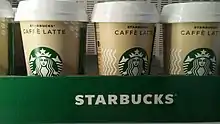
In July 2019, Starbucks announced that it would no longer be selling newspapers in its cafes. It was also announced that kiosks for grab-and-go snacks and bags of whole-bean coffee would be removed from stores beginning in September 2019.[118]
Locations
The company's headquarters is located in Seattle, Washington, United States, where 3,501 people worked as of January 2015.[119] The main building in the Starbucks complex was previously a Sears distribution center.
Current
As of May 2020, Starbucks has around 31,256 locations spanning 79 countries and territories on six continents:[120]
.png.webp)
Retail expansion
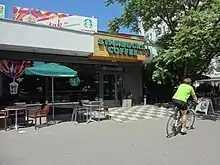
In 2008, Starbucks continued its expansion, settling in Argentina, Belgium, Brazil, Bulgaria, the Czech Republic, and Portugal.[21] European and Scandinavian expansion continued in 2009 with Poland (April),[123] Utrecht, Netherlands (August), and Sweden at Arlanda Airport outside Stockholm (October).[124] In 2010, growth in new markets continued. In May 2010, Southern Sun Hotels South Africa announced that they had signed an agreement with Starbucks to brew Starbucks coffees in select Southern Sun and Tsonga Sun hotels in South Africa. The agreement was partially reached so Starbucks coffees could be served in the country in time for the 2010 FIFA World Cup hosted by South Africa.[125] In June 2010, Starbucks opened its first store in Budapest, Hungary and in November, the company opened the first Central American store in El Salvador's capital, San Salvador.[126]
In December 2010, Starbucks debuted their first-ever Starbucks at sea, wherewith a partnership with Royal Caribbean International; Starbucks opened a shop aboard their Allure of the Seas Royal Caribbean's second-largest ship, and also the second-largest ship in the world.[127] A partnership with Algerian food company Cevital will see Starbucks open its first Algerian store in Algiers.[128] In January 2011, Starbucks and Tata Coffee, Asia's largest coffee plantation company, announced plans for a strategic alliance to bring Starbucks to India and also to source and roast coffee beans at Tata Coffee's Kodagu facility.[129] Despite a false start in 2007,[130] in January 2012, Starbucks created a 50:50 joint venture with Tata Global Beverages called Tata Starbucks. Tata Starbucks owned and operated Starbucks outlets in India as Starbucks Coffee "A Tata Alliance."[131] Starbucks opened its first store in India in Mumbai on October 19, 2012.[132][133][134]
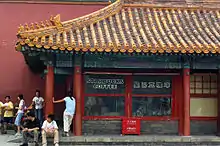
In February 2011, Starbucks started selling its coffee in Norway by supplying Norwegian food shops with their roasts. The first Starbucks-branded Norwegian shop opened on February 8, 2012, at Oslo Airport, Gardermoen. In October 2011, Starbucks opened another location in Beijing, China, at the Beijing Capital International Airport's Terminal 3, international departures hall; making the company's 500th store in China. The store is the 7th location at the airport. The company planned to expand to 1,500 stores in China by 2015.[135] In May 2012, Starbucks opened its first coffeehouse in Finland, with the location being Helsinki-Vantaa Airport in Vantaa.[136] In June 2012, Starbucks opened a store in San Jose, Costa Rica.[137] In October 2012, Starbucks announced plans to open 1,000 stores in the United States in the next five years.[138] The same month, the largest Starbucks in the US opened at the University of Alabama's Ferguson Center.[139]
In 2013, Starbucks met with Dansk Supermarked, which is the biggest retail company in Denmark. The first Starbucks inside Dansk Supermarked opened in August 2013 in the department stores Salling in Aalborg and Aarhus.[140] Starbucks has announced its first café in Bolivia would open in 2014 in Santa Cruz de la Sierra and the first in Panama in 2015.[141] On June 19, 2015, a Starbucks opened at Disney's Animal Kingdom on Discovery Island. Since the park does not allow plastic straws due to the animals, this location features special green eco-friendly straws with their cold drinks.[142] This was the sixth Starbucks to open in Walt Disney World, following locations in the Magic Kingdom (Main Street, U.S.A.), Epcot (Future World), Disney's Hollywood Studios (Hollywood Boulevard),[143] and two in Disney Springs (Marketplace and West Side). In addition to these six, there are locations in Disneyland (Main Street, U.S.A.), Disney California Adventure (Buena Vista Street), Anaheim's Downtown Disney, and Disney Village at Disneyland Paris. The Downtown Disney and Disney Springs locations are Starbucks-operated, while the locations inside of the theme parks are Disney-operated.[144]
Bill Sleeth, Starbucks's vice president of global design, has overseen efforts to make a neighborhood feel for new stores, saying "What you don't want is a customer walking into a store in downtown Seattle, walking into a store in the suburbs of Seattle and then going into a store in San Jose, and seeing the same store." Sleeth said "The customers were saying, 'Everywhere I go, there you are,' and not in a good way. We were pretty ubiquitous." As part of a change in compact direction, Starbucks management wanted to transition from the singular brand worldwide to focusing on locally relevant design for each store.[145] Starbucks's first Channel Island store was opened in early 2015, in the primary business area of St Peter Port in Guernsey.[146] In 2014 Starbucks was scheduled to open a store in Azerbaijan, in the Port Baku Mall.[147]
In August 2013, Starbucks's CEO, Howard Schultz, personally announced the opening of Starbucks stores in Colombia. The first café was set to open in 2014 in Bogotá and add 50 more stores throughout Colombia's main cities in a 5-year limit. Schultz also stated that Starbucks will work with both the Colombian Government and USAID to continue "empowering local coffee growers and sharing the value, heritage and tradition of its coffee with the world." Starbucks noted that the aggressive expansion into Colombia was a joint venture with Starbucks's Latin partners, Alsea and Colombia's Grupo Nutresa that has previously worked with Starbucks by providing coffee through Colcafe. This announcement comes after Starbucks's Farmer Support Center was established in Manizales, Colombia the previous year making Colombia an already established country by the corporation.[148]
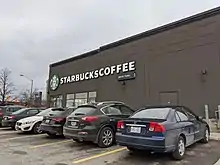
On April 21, 2015, Kesko, the second largest retailer in Finland, announced its partnership with Starbucks, with stores opened next to K-Citymarket hypermarkets.[149] As of June 2017, 3 stores had been opened next to K-Citymarkets: In Sello in Espoo and in Myyrmanni and Jumbo in Vantaa.[2] On December 18, 2015, Starbucks opened in Almaty, Kazakhstan. On the next day, 1 more coffee shop was opened.[150] The first Starbucks store in Slovakia opened in Aupark Shopping Center in Bratislava on May 31, 2016,[151][152] with two more stores confirmed to open in Bratislava by the end of 2016. In February 2016, Howard Schultz announced the opening of stores in Italy. The first Italian Starbucks store was inaugurated in Milan on September 6, 2018.[153] After Taste Holdings acquired outlet licensing for South African stores, Starbucks opened its first store in South Africa in Rosebank, Johannesburg on Thursday, April 21, 2016, and it is second in the country at the end of April in Mall of Africa.[154][155]
In May 2017, Starbucks announced it was commencing operations in Jamaica, where the first store is to open in the resort city of Montego Bay.[156] The company announced that its first store would be on located on the shores of the world-famous Doctor's Cave Beach, offering views of the Caribbean Sea.[157] Starbucks Jamaica expects thereafter to roll out a further 14 locations across the island by the year 2020. The company also reaffirmed its commitment to working with local coffee farmers to "implement systems to increase productivity and yields, while also increasing compliance to international standards."[158] Starbucks Jamaica officially opened its first store on November 21, 2017, with plans to open 15 locations islandwide over a 5-year period.[159] Starbucks Jamaica, recently opened its 3 stores at the Sangster International Airport in Montego Bay and one at the Historic Falmouth Pier, in Falmouth, Jamaica. Starbucks Jamaica announced its intention to open 2 stores in Jamaica's capital city, Kingston in 2018, with plans for up to 6 stores by 2019.[160] The first of the Kingston stores opened on June 21, 2018. The second store is located in the heart of Kingston's central business district, New Kingston. Starbucks is also opening its first in-store location in the new flagship location for Jamaica's largest Pharmacy chain, Fontana Pharmacy, also located in Kingston; making it Starbucks's third confirmed location.[161] This location will open in July 2019.
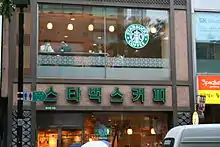
Caribbean Coffee Baristas, franchise-holders for Starbucks's Jamaican operations are set to open new stores in the Cayman Islands and the Turks and Caicos Islands; up to three stores are planned for the Caymans and a yet undisclosed number for the Turks & Caicos. The first of these stores will be opened by year-end of 2018.[162] At the end of December 2017, the world's biggest Starbucks store opened at HKRI Taikoo Hui in Shanghai, China. Starbucks announced the opening of stores in Serbia in late 2018.[163] The first store was opened in April 2019 at Rajićeva Mall. On June 1, 2019, Starbucks opened its first coffee store in Malta at Valletta. This will be the 80th country that will have a Starbucks outlet.[164][165]
Shifting focus in North America
In June 2020, during the COVID-19 pandemic in the United States however, the company announced that it would close 400 of its locations in the US/Canada region over the subsequent 18 months as it moves from the coffee house concept to what it calls "convenience-led" formats with drive-thru and curbside pickup; the new stores will work with the Starbucks App for pre-payment by the customer before arrival to pick up the order. The layout of some stores will also be modified with a separate counter for picking up mobile orders. The company also announced that it planned to open 300 stores that will primarily focus on carryout and pickup orders.[166][167]
Former stores
After losing $6 million on the six Starbucks[168] opened between 2001 and 2003,[169] and having struggled with fierce local competition, Starbucks, along with its partner Delek Group of Israel,[170] closed all six of its locations in Israel, citing "on-going operational challenges" and a "difficult business environment."[171][172] The Starbucks location in the former imperial palace in Beijing closed in July 2007. The coffee shop had been a source of ongoing controversy since its opening in 2000 with protesters objecting that the presence of the American chain in this location "was trampling on Chinese culture."[173][174] In July 2008, the company announced it was closing 600 underperforming company-owned stores and cutting U.S. expansion plans amid growing economic uncertainty.[175][176] On July 29, 2008, Starbucks also cut almost 1,000 non-retail jobs as part of its bid to re-energize the brand and boost its profit. Of the new cuts, 550 of the positions were layoffs and the rest were unfilled jobs.[177] These closings and layoffs effectively ended the company's period of growth and expansion that began in the mid-1990s.
Starbucks also announced in July 2008 that it would close 61 of its 84 stores in Australia in the following month.[178] Nick Wailes, an expert in strategic management of the University of Sydney, commented that "Starbucks failed to truly understand Australia's cafe culture."[179] In May 2014, Starbucks announced ongoing losses in the Australian market, which resulted in the remaining stores being sold to the Withers Group.[180] In January 2009, Starbucks announced the closure of an additional 300 underperforming stores and the elimination of 7,000 positions. CEO Howard Schultz also announced that he had received board approval to reduce his salary.[181] Altogether, from February 2008 to January 2009, Starbucks terminated an estimated 18,400 U.S. jobs and began closing 977 stores worldwide.[182] In August 2009, Ahold announced closures and rebranding for 43 of their licensed store Starbucks kiosks for their US based Stop & Shop and Giant supermarkets.[183][184] In July 2012, the company announced that they may begin closing unprofitable European stores immediately.[185]
Unbranded stores
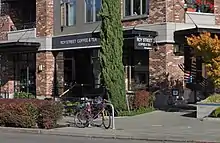
In 2009, at least three stores in Seattle were de-branded to remove the logo and brand name, and remodel the stores as local coffee houses "inspired by Starbucks."[186][187] CEO Howard Schultz called the unbranded stores a "laboratory for Starbucks".[188] The first, 15th Avenue Coffee and Tea, opened in July 2009 on Capitol Hill. It served wine and beer and hosted live music and poetry readings.[189] It has since been remodeled and reopened as a Starbucks-branded store. Another is Roy Street Coffee and Tea at 700 Broadway E., also on Capitol Hill. Although the stores have been called "stealth Starbucks"[186][190] and criticized as "local-washing,"[191] Schultz says that "It wasn't so much that we were trying to hide the brand, but trying to do things in those stores that we did not feel were appropriate for Starbucks."[188]
Licensed and franchise operations
Independently operated Starbucks locations exist. Stores that independently operate locations include Ahold Delhaize, Barnes & Noble, Target, Albertsons and, more recently, Publix stores. As of 2015, 4,962 licensed locations exist.[192] In the EMEA (Europe, Middle East, and Africa) markets, Starbucks operates a franchising program. Different from the licensing program in which existing corporations may apply to operate a Starbucks kiosk within an existing store, franchises can enable new, freestanding stores.
Automated locations
Starbucks has automated systems in some areas. These machines have 280 possible drink combinations to choose from. They have touchscreens and customers can play games while they wait for their order.[193]
Facilities
Free Wi-Fi Internet access varies in different regions. In Germany, customers get unlimited free Wi-Fi through BT Openzone, and in Switzerland and Austria, customers can get 30 minutes with a voucher card (through T-Mobile). Since 2003, Starbucks in the UK rolled out a paid Wi-Fi based on one-time, hourly or daily payment. Then, in September 2009, it was changed to 100% free Wi-Fi at most of its outlets. Customers with a Starbucks Card are able to log-on to the Wi-Fi in-store for free with their card details, thereby bringing the benefits of the loyalty program in line with the United States.[194] Since July 2010, Starbucks has offered free Wi-Fi in all of its US stores via AT&T and information through a partnership with Yahoo!. This is an effort to be more competitive against local chains, which have long offered free Wi-Fi, and against McDonald's, which began offering free wireless internet access in 2010.[195] On June 30, 2010, Starbucks announced it would begin to offer unlimited and free Internet access via Wi-Fi to customers in all company-owned locations across Canada starting on July 1, 2010.[196]
In October 2012, Starbucks and Duracell Powermat announced a pilot program to install Powermat charging surfaces in the tabletops in selected Starbucks stores in the Boston area.[197] Furthermore, Starbucks announced its support in the Power Matters Alliance (PMA) and its membership in the PMA board, along with Google and AT&T, in an effort to create "a real-world ecosystem of wireless power" through a universal wireless charging standard that customers could use to recharge smartphones.[198]
Advertising
Logo
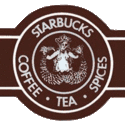

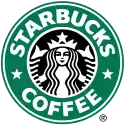

In 2006, Valerie O'Neil, a Starbucks spokeswoman, said that the logo is an image of a "twin-tailed mermaid, or siren as she's known in Greek mythology."[199] The logo has been significantly streamlined over the years. In the first version,[200] the Starbucks siren was topless and had a fully visible double fish tail.[201] The image also had a rough visual texture and has been likened to a melusine.[202] The image is said by Starbucks to be based on a 16th-century "Norse" woodcut, although other scholars note that it is apparently based on a 15th-century woodcut in J.E. Cirlot's Dictionary of Symbols.[203][204] In the second version, which was used from 1987 to 1992, her breasts were covered by her flowing hair, but her navel was still visible.[205] The fish tail was cropped slightly, and the primary color was changed from brown to green, a nod to the Alma Mater of the three founders, the University of San Francisco.[206][207] In the third version, used between 1992 and 2011, her navel and breasts are not visible at all, and only vestiges remain of the fish tails. The original "woodcut" logo has been moved to the Starbucks's Headquarters in Seattle.
At the beginning of September 2006 and then again in early 2008, Starbucks temporarily reintroduced its original brown logo on paper hot-drink cups. Starbucks has stated that this was done to show the company's heritage from the Pacific Northwest and to celebrate 35 years of business. The vintage logo sparked some controversy due in part to the siren's bare breasts,[208] but the temporary switch garnered little attention from the media. Starbucks had drawn similar criticism when they reintroduced the vintage logo in 2006.[209] The logo was altered when Starbucks entered the Saudi Arabian market in 2000 to remove the siren, leaving only her crown,[210] as reported in a Pulitzer Prize-winning column by Colbert I. King in The Washington Post in 2002. The company announced three months later that it would be using the international logo in Saudi Arabia.[211] In January 2011, Starbucks announced that they would make small changes to the company's logo, removing the Starbucks wordmark around the siren, enlarging the siren image, and making it green.[212]
Partnerships
Starbucks has agreed to a partnership with Apple to collaborate on selling music as part of the "coffeehouse experience." In October 2006, Apple added a Starbucks Entertainment area to the iTunes Store, selling music similar to that played in Starbucks stores. In September 2007, Apple announced that customers would be able to browse the iTunes Store at Starbucks via Wi-Fi in the US—with no requirement to log into the Wi-Fi network—targeted at iPhone, iPod touch, iPad, and MacBook users. The iTunes Store will automatically detect recent songs playing in a Starbucks and offer users the opportunity to download the tracks. Some stores feature LCD screens with the artist name, song, and album information of the current song playing. This feature has been rolled out in Seattle, New York City, and the San Francisco Bay Area, and was offered in limited markets during 2007–2008.[213] During the fall of 2007, Starbucks also began to sell digital downloads of certain albums through iTunes. Starbucks gave away 37 different songs for free download through iTunes as part of the "Song of the Day" promotion in 2007, and a "Pick of the Week" card is now available at Starbucks for a free song download. Since 2011, Starbucks also gives away a "Pick of the Week" card for app downloads from the App Store. A Starbucks app is available in the iPhone App Store.
Starting on June 1, 2009, the MSNBC morning news program Morning Joe has been presented as "brewed by Starbucks" and the show's logo changed to include the company logo. Although the hosts have previously consumed Starbucks coffee on air "for free" in the words of MSNBC president Phil Griffin, it was not paid placement at that time.[214] The move was met with mixed reactions from rival news organizations, viewed as both a clever partnership in an economic downturn and a compromise of journalistic standards.[215] Starbucks and Kraft Foods entered into a partnership in 1998 to sell Starbucks products in the Mondelez grocery stores owned by the latter. Starbucks claimed that Kraft did not sufficiently promote its products and offered Kraft US$750 million to terminate the agreement; however, Kraft declined the offer, but Starbucks proceeded with the termination anyway. Starbucks wanted to terminate the agreement because at the time, single coffee packs were beginning to become popular. In their agreement, Starbucks was confined to selling packs that only worked in Kraft's Tassimo machines. Starbucks didn't want to fall behind in the market opportunities for k cups.[216] In mid-November 2013, an arbitrator ordered Starbucks to pay a fine of US$2.8 billion to Kraft spin-off Mondelez International for its premature unilateral termination of the agreement.[217][218][219]
In June 2014, Starbucks announced a new partnership with Arizona State University (ASU) that would allow Starbucks employees in their Junior and Senior years of college to complete four years of college at Arizona State University's online program for only around 23K. Starbucks employees admitted into the program will receive a scholarship from the college, College Achievement Plan (CAP), that will cover 44% of their tuition. The remaining balance and all other expenses would be paid by the student or through traditional financial aid. In April 2015, Starbucks and ASU announced an expansion of the College Achievement Program. The program would now allow all eligible part-time and full-time employees working in a U.S. Starbucks to enroll in the program for full-tuition reimbursement.[220] After the completion of each semester, Starbucks reimburses the student their portion of the tuition. The student can then use the reimbursement to pay any loans or debt incurred during the semester.[221]
In 2015, Starbucks signed a deal with PepsiCo to market and distribute Starbucks products in several Latin American countries for 2016.[222] In May 2015, Starbucks entered a partnership with music streaming service Spotify. The partnership entailed giving U.S.-based employees a Spotify premium subscription and to help influence the music played in store via playlists made using Spotify. Starbucks was also given its own curated Spotify playlist to be featured on Spotify's mobile app.[223] In March 2020, Starbucks announced that starting from April 6, their employees could use up to 2 free mental health therapy sessions for themselves or their family members, like a partner/spouse or children. They can meet with a counselor face-to-face or video call and will also have unlimited access to self-care apps through Lyra Health Inc.[224]
Parodies and infringements

Starbucks has been a target of parodies and imitations of its logo, particularly the 1992 version, and has used legal action against those it perceives to be infringing its intellectual property. In 2000, San Francisco cartoonist Kieron Dwyer was sued by Starbucks for copyright and trademark infringement after creating a parody of its siren logo and putting it on the cover of one of his comics, later placing it on coffee mugs, T-shirts, and stickers that he sold on his website and at comic book conventions. Dwyer felt that since his work was a parody it was protected by his right to free speech under U.S. law. The case was eventually settled out of court, as Dwyer claimed he did not have the financial ability to endure a trial case with Starbucks. The judge agreed that Dwyer's work was a parody and thus enjoyed constitutional protection; however, he was forbidden from financially "profiting" from using a "confusingly similar" image of the Starbucks siren logo. Dwyer was allowed to display the image as an expression of free speech, but he can no longer sell it.[225] In a similar case, a New York store selling stickers and T-shirts using the Starbucks logo with the phrase "Fuck Off" was sued by the company in 1999.[226][227] An anti-Starbucks website, starbuckscoffee.co.uk, which encouraged people to deface the Starbucks logo[228] was transferred to Starbucks in 2005,[229][230] but has since resurfaced at www.starbuckscoffee.org.uk. Christian bookstores and websites in the US are selling a T-shirt featuring a logo with the siren replaced by Jesus and the words "Sacrificed for me" around the edge.[231]
Other successful cases filed by Starbucks include the case won in 2006 against the chain Xingbake in Shanghai, China for trademark infringement, because the chain used a green-and-white circular logo with a name that sounded phonetically similar to the Chinese for Starbucks.[232] Starbucks did not open any stores after first registering its trademark in Russia in 1997, and in 2002 a Russian lawyer successfully filed a request to cancel the trademark. He then registered the name with a Moscow company and asked for $600,000 to sell the trademark to Starbucks, but was ruled against in November 2005.[48] In 2003, Starbucks sent a cease-and-desist letter to "HaidaBucks Coffee House" in Masset, British Columbia, Canada. The store was owned by a group of young Haida men, who claimed that the name was a coincidence, due to "buck" being a Haida word for "young man" (a claim that cannot be substantiated). After facing criticism, Starbucks dropped its demand after HaidaBucks dropped "coffee house" from its name.[233] In the 2004 DreamWorks Animation film Shrek 2, Starbucks is parodied as Farbucks in the kingdom of Far Far Away, which in turn, is a parody of a medieval version of Hollywood, California.
Sam Buck Lundberg, who owns a coffee store in Oregon, was prohibited from using "Sambuck's Coffee" on the shop front in 2006.[234] Starbucks lost a trademark infringement case against a smaller coffee vendor in South Korea that operates coffee stations under the name Starpreya. The company, Elpreya, says Starpreya is named after the Norse goddess, Freja, with the letters of that name changed to ease pronunciation by Koreans. The court rejected Starbucks's claim that the logo of Starpreya is too similar to their own logo.[235] A bar owner in Galveston, Texas, USA[236] won the right to sell "Star Bock Beer" after a lawsuit by Starbucks in 2003 after he registered the name,[236] but the 2005 federal court ruling also stated that the sale of the beer must be restricted to Galveston, a ruling upheld by the Supreme Court in 2007.
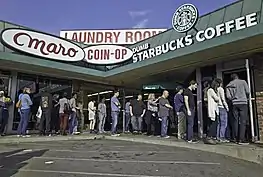
Ongoing cases include a dispute over the copyright application for Seattle's Rat City Rollergirls logo in 2008.[237] The company claimed the roller derby league's logo by a Washington artist[238] was too similar to its own. Starbucks requested an extension to further examine the issue and possibly issue a complaint, which was granted by the Trademark Office. The July 16, 2008, deadline passed without action by the corporation.[239] Starbucks launched action against an Indian cosmetics business run by Shahnaz Husain, after she applied to register the name Starstruck for coffee and related products. She said she aimed to open a chain of stores that would sell coffee and chocolate-based cosmetics.[240] A cafe in Al-Manara Square,[241] Ramallah, Palestinian Territories, opened in 2009 with the name "Stars and Bucks" and a logo using a similar green circle and block lettering.[242] Like Starbucks, the Stars and Bucks serves cappuccinos in ceramic cups, and offers free Wifi. According to speculation cited in the Seattle Post Intelligencer, the cafe's name and imitation Starbucks style may be a political satire of American consumerism. Starbucks is not known to have taken action against this business.
In 2014, Nathan Fielder, a Canadian comedian behind the hit show Nathan for You, opened a store called "Dumb Starbucks Coffee" in Los Feliz, Los Angeles CA. The store resembled a typical Starbucks with one exception: everything was preceded by the word "dumb." For example, the drinks he carried included Dumb Skinny Vanilla Lattes and Dumb Frapuccinos.[243] The store carried music titled "Dumb Jazz Standards" and "Dumb Norah Jones Duets."[244] He thought he could bypass infringement and copyright claims through the "Parody Law," referring to the parody aspect of Fair Use laws (that protect parodists such as "Weird Al" Yankovic and SNL). No lawsuits were filed though because the store was short-lived. The Los Angeles Health Department shut it down after 4 days because Fielder lacked the proper permits.[245][246] Others have used the Starbucks logo unaltered and without permission, such as a café in Pakistan that used the logo in 2003 in its advertisements[247] and a cafe in Cambodia in 2009, the owner saying that "whatever we have done we have done within the law."[248]
Environmental and social policies
Environmental impact
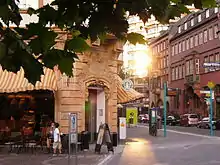
In 1999, Starbucks started "Grounds for your Garden" to make their business environmentally friendlier. This gives leftover coffee grounds to anyone requesting it for composting. Although not all stores and regions participate, customers can request and lobby their local store to begin the practice. In October 2008, The Sun newspaper reported that Starbucks was wasting 23.4 million liters (6.2 million US gal) of water a day by leaving a tap constantly running for rinsing utensils in a 'dipper well' in each of its stores, but this is often required by governmental public health code.[249]
In June 2009, in response to concerns over its excessive water consumption, Starbucks re-evaluated its use of the dipper well system. In September 2009, company-operated Starbucks stores in Canada and the United States successfully implemented a new water saving solution that meets government health standards. Different types of milk are given a dedicated spoon that remains in the pitcher and the dipper wells were replaced with push button metered faucets for rinsing. This will reportedly save up to 150 US gal (570 l) of water per day in every store.[250]
Recycling
Starbucks began using 10% recycled paper in its beverage cups in 2006—the company claimed that the initiative was the first time that recycled material had been used in a product that came into direct contact with a food or beverage.[251] Allen Hershkowitz of the Natural Resources Defense Council called the 10% content "minuscule,"[251] but Starbucks received the National Recycling Coalition Recycling Works Award in 2005 for the initiative.[252] In a 2008 media article, Starbucks's vice president of corporate social responsibility acknowledged that the company continued to struggle with environmental responsibility, as none of its cups were recyclable and stores did not have recycling bins. At the time that the article was published, Starbucks gave customers who brought in their own reusable cup a 10-cent discount, in addition to using corrugated cup sleeves made from 85 percent post-consumer recycled fiber, which is 34 percent less paper than the original. During the same period, Starbucks entered into a partnership with Conservation International—pledging US$7.5 million over three years—to help protect the natural environment of coffee-growing communities in Mexico and Indonesia.[253]
Farmer equity practices
Starbucks began drafting plans for corporate social responsibility in 1994.[254] Since Starbucks has partnered with Conservation International (CI) to draft plans and audit its coffee and farmer equity (C.A.F.E.) program,[255] Starbucks's C.A.F.E. practices are based on a rating system of 249 indicators. Farmers who earn high overall scores receive higher prices than those who achieve lower scores. Ratings categories include economic accountability, social responsibility, environmental leadership in coffee growing and processing. Indicators for social responsibility have evolved and now include 'zero tolerance' indicators that require workers to be paid in cash, check, or direct deposit, ensure that all workers are paid the established minimum wage, that workplaces are free of harassment and abuse, that workplaces are nondiscriminatory and do not employ persons under the age of 14, and several more.[256] Starbucks has moved 90% of its coffee purchases to preferred C.A.F.E. certified providers, and the company is approaching its stated goal to purchase 100% of its coffee through C.A.F.E. or other 'ethically sourced' certification systems.[255]
Washington State University Assistant Professor Daniel Jaffee argues that Starbucks's C.A.F.E. practices merely 'green wash' "to burnish their corporate image."[257] Additionally, Professor Marie-Christine Renard of Rural Sociology of Chapingo University in Mexico wrote a case study of Starbucks's, Conservation International's, and Agro-industries United of Mexico (AMSA)'s joint conservation effort in Chiapas, Mexico in which she concluded that "[w]hile the CI-Starbucks-AMSA Alliance paid better prices, it did not allow the producers to appropriate the knowledge that was necessary for the organizations to improve the quality of their coffee."[258]
Fair trade
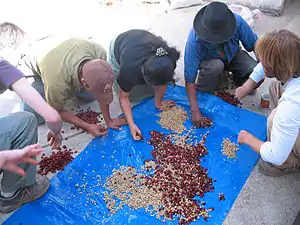
In 2000, the company introduced a line of fair trade products.[259] Of the approximately 136,000 tons (300 million pounds) of coffee Starbucks purchased in 2006, about 18 million pounds or 6% was certified as fair trade.[260] All espresso roast sold in the UK and Ireland is Fairtrade.[261] Questions have been raised regarding the legitimacy of the Fair Trade designation.[262] Groups such as Global Exchange are calling for Starbucks to further increase its sales of fair trade coffees.[263] According to Starbucks, in 2004 it paid on average $1.42 per pound ($2.64 kg) for high-quality coffee beans, 74% above the commodity prices at the time.[264]
After a long-running dispute between Starbucks and Ethiopia, Starbucks agreed to support and promote Ethiopian coffees. An article in BBC News,[265] states that Ethiopian ownership of popular coffee designations such as Harrar and Sidamo is acknowledged, even if they are not registered. Ethiopia fought hard for this acknowledgement mainly to help give its poverty-stricken farmers a chance to make more money. In 2006, Starbucks said it paid $1.42 per pound for its coffee. The coffee Starbucks bought for $1.42 per pound, had a selling price—after transportation, processing, marketing, store rentals, taxes, and staff salary and benefits—of $10.99 per pound.[266] As of 2013, the Starbucks website sells only one Ethiopian coffee.[267][268] In addition, Starbucks is an active member of the World Cocoa Foundation.
Ethos water
Ethos, a brand of bottled water acquired by Starbucks in 2003, is sold at locations throughout North America. Ethos bottles feature prominent labeling stating "helping children get clean water," referring to the fact that US$0.05 from each US$1.80 bottle sold (US$0.10 per bottle in Canada) is used to fund clean water projects in under-developed areas. Although sales of Ethos water have raised over US$6.2 million for clean water efforts, the brand is not incorporated as a charity. Critics have argued that the claim on the label misleads consumers into thinking that Ethos is primarily a charitable organization when it is actually a for-profit brand and the vast majority of the sale price (97.2%) does not support clean-water projects.[269][270] The founders of Ethos have stated that the brand is intended to raise awareness of third-world clean water issues and provide socially responsible consumers with an opportunity to support the cause by choosing Ethos over other brands.[271] Starbucks has since redesigned the American version of the Ethos water bottles, stating the amount of money donated per bottle in the description.
Food bank donations
Since 2010, Starbucks has been donating leftover pastries in the United States to local food banks through a food collection service named Food Donation Connection.[272] In March 2016, Starbucks unveiled a five-year plan to donate 100 percent of unsold food from its 7,600 company-operated stores in the U.S. to local food banks and pantries.[273] Perishable food will be transported in refrigerated trucks to area food banks through the company's partnerships with the Food Donation Connection and Feeding America. This program, called FoodShare, is expected to provide up to 50 million meals over the next five years.[274] As of 2017, the program was in 10 different markets, including New York City.[275] In New York, Starbucks works with Feeding America and City Harvest, both non-profits, to donate food from 45 locations. It plans to expand the program to all 305 Manhattan stores. In September 2019, 60% of Starbucks stores are participating in FoodShare. This level of participation contributed to 20 million meals served to those in need.[276]
2020 plastic straw ban
On July 9, 2018, Starbucks President and CEO Kevin Johnson announced that Starbucks will ban the single-use plastic straws by January 1, 2020 on all cold drinks from all locations worldwide due to climate change concerns, pollution, and sea turtle endangerment as the single-use plastic straws failed to be designed for recycling when they were invented. Frappucinos will get straws made from a different material that is sustainable and environmentally friendly such as paper or compostable plastic, while other cold drinks will get straw-less lids. However, the new lids will actually have more plastic than the old lid-straw combination but they are recyclable unlike the old lid-single-use straw combination.[277] The Starbucks locations in Europe, China, Taiwan, Japan, Thailand, Vietnam, India, Canada, Hawaii, Alaska, Washington D.C., New Mexico, California, New York, Washington State, New Jersey, Oregon, Maryland, Delaware, Vermont, Massachusetts, Connecticut, and Rhode Island already eliminated plastic straws by the end of 2018.[278][279] South Korea is the first country to introduce paper straws to all stores among 78 countries in the world that Starbucks has entered.[280]
Music, film, and television
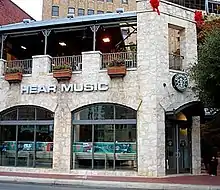
Hear Music began as a music catalog company in 1990, adding a few retail locations in the San Francisco Bay Area. Hear Music was purchased by Starbucks in 1999.[281] In 2002, they produced a Starbucks opera album, featuring artists such as Luciano Pavarotti, followed in March 2007 by the hit CD "Memory Almost Full" by Paul McCartney, making McCartney the first artist signed to the new Hear Music label sold in Starbucks outlets.[282] In 2006, the company created Starbucks Entertainment, one of the producers of the 2006 film Akeelah and the Bee. Retail stores advertised the film before its release and sold the DVD.[283]
Starbucks has become the subject of a protest song, "A Rock Star Bucks a Coffee Shop" by Neil Young and his band, Promise of the Real. This single from the album The Monsanto Years criticized both Starbucks's alleged use of genetically modified food and the GMO company Monsanto.[284][285]
See also
References
- Kavilanz, Parija. "Starbucks unveils a new logo". CNN. Retrieved January 22, 2018.
- "Loxcel Starbucks Map". Starbucks. June 10, 2018. Archived from the original on September 28, 2015. Retrieved June 10, 2018.
- "Starbucks financial report 2017". NASDAQ.
- "Starbucks". forbes.com. May 2013. Retrieved February 21, 2014.
- "Annual Report 2019" (PDF). Starbucks. Retrieved October 4, 2020.
- Sacks, Danielle (September 2014). "The Multimillion Dollar Quest To Brew The Perfect Cup Of Coffee". Fast Company. Retrieved October 31, 2015.
- "Tech ideas are brewing at these 5 coffee-crazed Seattle startups — and right in Starbucks' backyard". GeekWire. August 22, 2019. Retrieved September 10, 2019.
- Robinson, Melia. "Starbucks is opening premium stores where you can buy coffee flights and cold-brew floats — take a look inside". Business Insider. Retrieved July 28, 2020.
- Starbucks "1st and Pike" Archived March 25, 2019, at the Wayback Machine, "Starbucks", 2016
- Time Out (2011). Time Out Guide San Francisco. Time Out Guides. ISBN 978-1-84670-220-4. Retrieved April 9, 2013.
- Pendergrast, pp. 252–53
- "How Starbucks got its name – Seattle's Big Blog". Seattle Post-Intelligencer. Retrieved October 21, 2015.
- Allison, Melissa (March 9, 2008). "Starbucks co-founder talks about early days, launching Redhook and Seattle Weekly, too". The Seattle Times.
- Brewer, Stephen; Brissenden, Constance; Carmin, Anita (2012). Pacific Northwest (New ed.). London: Dorling Kindersley. pp. 135–. ISBN 9781405370813. OCLC 795852938.
- Linda Dono Reeves (September 8, 1992). "Coffee firm's plans to go national are percolating". USA Today.
- Hsu, Tiffany (July 23, 2012). "Peet's Coffee & Tea sold for nearly $1 billion, but not to Starbucks". Los Angeles Times. ISSN 0458-3035. Retrieved March 6, 2019.
- "Starbucks Corporation." Student Resources. N.p., n.d. Web. March 13, 2013.
- Robichaux, Mark (November 6, 1989). "Boom in Fancy Coffee Pits Big Marketers, Little Firms". The Wall Street Journal.
- Fabricant, Florence (September 2, 1992). "Americans Wake Up and Smell the Coffee". The New York Times. ISSN 0362-4331. Retrieved March 1, 2019.
- "Archived copy" (PDF). Archived from the original (PDF) on September 6, 2015. Retrieved October 27, 2016.CS1 maint: archived copy as title (link)
- "Forty years young: A history of Starbucks". The Daily Telegraph. London. May 11, 2011. Retrieved November 13, 2012.
- Fool, Contributor Jeremy Bowman The Motley. "If You Had Invested $1,000 in Starbucks' IPO, Here's How Much You'd Have Today". www.nasdaq.com. Retrieved July 28, 2020.
- "Interest brews for Starbucks Coffee retailer makes stock offering amid latest java craze". The Globe and Mail. June 17, 1992.
- Etherington, Darrell (July 26, 2013). "Mobile Payment At U.S. Starbucks Locations Crosses 10% As More Stores Get Wireless Charging". TechCrunch. Retrieved March 1, 2019.
- Ajani, Saif (December 5, 2013). "Starbucks' @Tweetacoffee Campaign Generated $180,000 in Sales, HUGE Long-term Benefits". Keyhole. Keyhole. Archived from the original on December 15, 2013. Retrieved December 24, 2013.
- Wasserman, Todd (December 6, 2013). "Starbucks 'Tweet-a-Coffee' Campaign Prompted $180,000 in Purchases". Mashable. Retrieved December 7, 2013.
- "Fortune 500 Companies 2018: Who Made the List". Fortune. Retrieved November 18, 2018.
- "Starbucks' stock pops after coffee chain crushes estimates, raises forecast". CNBC. Retrieved July 25, 2019.
- Business, Clare Duffy, CNN. "Starbucks sales are still getting crushed by coronavirus". CNN. Retrieved November 15, 2020.
- Business, Danielle Wiener-Bronner, CNN. "Starbucks plans to open about 22,000 stores in the next ten years". CNN. Retrieved December 26, 2020.
- "Starbucks Revenue 2006-2018 | SBUX". www.macrotrends.net. Retrieved October 28, 2018.
- Szabo, Liz (July 29, 1996). "Launching Starbucks In Japan -- First Of 15 Stores To Open". The Seattle Times. Retrieved October 19, 2012.
- Lim Uy, Sasha (December 1, 2017). "Do You Remember the First Starbucks in the Philippines?". Esquire. Philippines. Retrieved December 3, 2017.
- "Starbucks in the Philippines". Retrieved December 3, 2017.
- "McDonald's Corp. Betting That Coffee Is Britain's Cup of Tea". The New York Times. The Associated Press. March 28, 1999. ISSN 0362-4331. Retrieved March 1, 2019.
- Tice, Carol (October 17, 1999). "Starbucks still seeking a rhythm for Circadia". BizJournals.
- Tice, Carol (October 15, 1999). "Starbucks still seeking a rhythm for Circadia". Puget Sound Business Journal. Retrieved May 13, 2009.
- "Starbucks in Australia". Starbucks Coffee Australia. Starbucks Coffee Australia. Retrieved August 14, 2019.
- Robb, Kirsten (May 28, 2014). "Rich List family behind Australia's 7-Eleven snaps up Starbucks". Smart Company. Private Media Pty Ltd. Retrieved August 14, 2019.
- Turner, Ashley (July 25, 2018). "Why there are almost no Starbucks in Australia". CNBC.com. CNBC. Retrieved August 14, 2019.
- "Starbucks Opens Coffee Shop in Mexico - 2002-09-07 | Voice of America - English". www.voanews.com. Retrieved July 28, 2020.
- Miguel Ángel Pallares Gómez (March 29, 2016). "Starbucks sigue como prioridad para Alsea". El Universal. El Universal. Retrieved September 22, 2016.
- "Starbucks establishes coffee trading company in Switzerland". BizJournals. October 17, 2002.
- "Starbucks establishes coffee trading company in Switzerland". October 17, 2002. Retrieved November 12, 2012.
- Frey, Christine (April 16, 2003). "A grande deal for Starbucks". Seattle Post-Intelligencer. Retrieved December 1, 2012.
- Hirsch, Jerry (September 15, 2006). "Diedrich to Sell Cafes to Rival". Los Angeles Times. Retrieved May 13, 2009.
- "Starbucks enters South America through Peru". Puget Sound Business Journal. August 19, 2003.
- Kramer, Andrew E. (September 7, 2007). "After Long Dispute, a Russian Starbucks". The New York Times. ISSN 0362-4331. Retrieved March 1, 2019.
- Schwaner-Albright, Oliver (March 26, 2008). "Tasting the Future of Starbucks Coffee From a New Machine". The New York Times. ISSN 0362-4331. Retrieved March 1, 2019.
- Schofield, Jack (March 24, 2008). "Starbucks lets customers have their say". The Guardian. London. Retrieved March 18, 2009.
- "Card Rewards". Starbucks.com. Retrieved October 24, 2010.
- Roark, Marc (2014). "Payment Systems, Consumer Tragedy, and Ineffective Remedies". St. Johns Law Review. 86: Forthcoming. SSRN 2211013.
- Baertlein, Lisa; Geller, Martinne (November 14, 2012). "Starbucks to buy Teavana in another step beyond coffee". Reuters. Retrieved November 14, 2012.
- Allison, Melissa (December 31, 2012). "Starbucks closes Teavana deal". The Seattle Times. Retrieved March 1, 2013.
- "STARBUCKS TO OPEN 1ST VIETNAM CAFE". Associated Press. Retrieved January 3, 2013.
- "Starbucks, McDonald's go Vietnam". Investvine. January 4, 2013. Retrieved January 14, 2013.
- "Starbucks opens first store in coffee-loving Vietnam". Archived from the original on November 3, 2014.
- AAP (August 28, 2013). "Starbucks to open first cafe in Colombia". The Australian. Retrieved August 28, 2013.
- Boden, Rian (June 4, 2014). "Starbucks Korea lets customers place orders with their mobile phone, more countries to follow". NFC World+. SJB Research. Retrieved March 21, 2019.
- Park, Jae-hyuk (April 30, 2017). "Starbucks Korea sees boom in mobile orders". The Korea Times. Hankook ilbo. Retrieved March 21, 2019.
- Top Mobile Trends (December 8, 2015). "Starbucks Launches First Mobile Order & Pay". Top Mobile Trends. Retrieved July 28, 2016.
- Kate, Taylor (March 27, 2018). "Starbucks is bringing back a promotion that baristas hate — but there's a catch". Business Insider. Retrieved March 21, 2019.
- Kate, Taylor (March 27, 2018). "Starbucks just quietly made a change that reveals the future of the company — here's how it works". Business Insider. Retrieved March 21, 2019.
- "New Starbucks in Williamsburg to Serve Alcohol". Thirsty NYC. August 19, 2014. Archived from the original on August 22, 2014. Retrieved August 21, 2014.
- "Starbucks buying full control of Japan unit for $914 million". Reuters (Press release). September 23, 2014.
- "Starbucks Announces Plans to Bring its Unique Coffeehouse Experience to the Vibrant Cambodian Market". Starbucks Newsroom. August 26, 2015.
- "Starbucks to Open Stores in Italy". Starbucks Newsroom. February 28, 2016.
- Brown, Peter (August 26, 2016). "Wireless Charging Pads Come to Starbucks". Electronics 360. Retrieved November 21, 2016.
- Landini, Francesca (September 19, 2017). "Coffee rivals square off in Italy ahead of Starbucks invasion". Reuters. Retrieved April 16, 2018.
- +01:00 (February 16, 2017). "Get ready: Up to 300 Starbucks stores are coming to Italy - The Local". Thelocal.it. Retrieved November 16, 2017.CS1 maint: numeric names: authors list (link)
- "Starbucks debuts its own original content series, "Upstanders," featuring video and podcasts". TechCrunch. Retrieved July 28, 2020.
- Perez, Sarah (September 7, 2016). "Starbucks debuts its own original content series, "Upstanders," featuring video and podcasts". TechCrunch. Retrieved September 9, 2016.
- "Starbucks buys out China venture in company's largest acquisition". FoodBev Media. July 27, 2017. Retrieved August 6, 2017.
- "Starbucks explores potential use of blockchain tech for 'bean to cup' pilot program". GeekWire. March 22, 2018. Retrieved March 27, 2018.
- Wiener-Bronner, Danielle (June 19, 2018). "Starbucks says it will close 150 stores next year". CNN Money. Retrieved June 20, 2018.
- Rogers, Sarah Whitten, Kate (December 13, 2018). "Starbucks cuts long-term earnings per share forecast; shares fall". www.cnbc.com. Retrieved December 13, 2018.
- Business, Jordan Valinsky, CNN. "Starbucks opens its biggest store ever". CNN. Retrieved November 18, 2019.
- "Starbucks is closing thousands of cafe-only stores across the US, keeping drive-thrus open and paying workers for 30 days whether they come to work or not". Business Insider. Retrieved March 21, 2020.
- Sherman, Natalie (April 28, 2020). "Cars out, snacks in as virus impacts US profits". BBC News. Retrieved May 1, 2020.
- LeVine, Steve (July 28, 2020). "The Uncertain Future of Post-Pandemic Starbucks". Marker. Medium (website). Retrieved July 30, 2020.
- "Starbucks targets new market, in coffee exporting Laos". The Independent. January 1, 1970. Retrieved November 5, 2020.
- Gelles, David (June 17, 2018). "The C.E.O. of Starbucks Isn't Leaving. Only Howard Schultz Is". The New York Times. ISSN 0362-4331. Retrieved July 28, 2020.
- "New Starbucks chairman Mike Ullman, who once led J.C. Penney, shares history with brand's departing leader Howard Schultz". Dallas News. June 5, 2018. Retrieved July 28, 2020.
- Kiviat, Barbara (December 10, 2006). "The Big Gulp at Starbucks". TIME.
- Lerman, Rachel (January 9, 2015). "Schultz: Starbucks COO not leaving for health concerns, rumors are 'irresponsible'". Puget Sound Business Journal.
- Whitten, Sarah (June 4, 2018). "Howard Schultz, architect of modern Starbucks, to step down as executive chairman". CNBC. Retrieved July 28, 2020.
- Jargon, Julie (October 6, 2015). "Starbucks Hires First Chief Technology Officer". WSJ.
- Youngme, M. & Quelch J. Starbucks: Delivering Customer Service. Boston, MA: Harvard Business School Pub., 2003. Online.
- Stanley, A. (2002). Starbucks Coffee Company. (case study). Tuck School of Business at Dartmouth.
- https://investor.starbucks.com/corporate-governance/board-of-directors/default.aspx Starbucks
- Nanos, Janelle (December 7, 2012). "The Story of the Frappuccino: How a chilly coffee drink became a billion-dollar behemoth". Boston Magazine. Retrieved October 30, 2013.
- T., Katie (April 16, 2010). "A Cup of Low-Cal Goodness". Starbucks. Archived from the original on February 4, 2013. Retrieved February 5, 2013.
- Food Ingredients Online (January 9, 2008). "Starbucks Latte And Mocha Offerings Get A Skinny Makeover To Help Coffee Lovers Feel Great In 2008". VertMarkets, Inc. Retrieved February 5, 2013.
- Baertlein, Lisa (June 3, 2009). "Starbucks revamps bakery food ingredients". Reuters.
- Jargon, Julie (September 30, 2009). "Starbucks Takes New Road With Instant Coffee". The Wall Street Journal. ISSN 0099-9660. Retrieved March 1, 2019.
- Miller, Michael (April 5, 2012). "Wine, beer at Starbucks?". Huntington Beach Independent. p. A4. Retrieved April 7, 2012.
- Corbett, Alexandra (January 18, 2011). "Thirsty? Starbucks Supersizes to the Trenta". The Norwalk Daily Voice. Retrieved July 19, 2012.
- Strom, Stephanie (September 20, 2012). "Starbucks to Introduce Single-Serve Coffee Maker". The New York Times. ISSN 0362-4331. Retrieved March 1, 2019.
- "Starbucks to open U.S. juice bars in 2012". Reuters. November 11, 2011.
- Green Coffee Extract Archived January 16, 2014, at the Wayback Machine at Starbucks.com. Excerpt from Brian Smith, Director of Global Beverage Innovation: "100% green arabica coffee beans ... We start with high-quality, green coffee beans. We soak the beans in water and pull out the caffeine and other good stuff. Then we dry the whole concoction down to create the concentrated essence and goodness of green coffee. That's Green Coffee Extract." Retrieved July 20, 2012.
- "Starbucks to post calorie counts nationwide". WABC TV. Archived from the original on June 24, 2013. Retrieved June 23, 2013.
- "starbucks.com". Starbucks Newsroom. Retrieved November 23, 2014.
- Horovitz, Bruce (February 4, 2015). "Starbucks to roll out coconut milk option". USA Today. Retrieved December 11, 2015.
- "Starbucks First Barrel-Aged Coffee Debuts at Seattle Roastery". Starbucks Newsroom. Retrieved March 8, 2017.
- Paul R. La Monica (March 7, 2017). "Starbucks unveils whiskey barrel-aged coffee. Yum!". CNN Money. Retrieved March 8, 2017.
- "Starbucks will buy Tazo tea company". Puget Sound Business Journal. January 13, 1999. bizjournals.com. Retrieved November 13, 2012.
- Jargon, Julie. "Starbucks To Acquire Tea Chain Teavana". The Wall Street Journal (print). p. B9.
- Choi, Candice; Skidmore, Sarah (November 14, 2012). "Starbucks Buys Teavana". The Huffington Post. Archived from the original on March 8, 2016.
- "Starbucks Launches Teavana Hot Brewed Tea in Starbucks Stores in the U.S. and Canada". January 2, 2015. starbucks.com. Retrieved June 3, 2015.
- Allison, Melissa (March 10, 2010). "Coffee wrap: Starbucks spent $740K on lobbying last year, Le Whif, and an old hand takes a swipe at 'third wave' coffee". The Seattle Times.
- "A triple-venti-Americano-decaf surprise? Consumer Reports finds McDonald's coffee better than Starbucks". NBC News. February 4, 2007. Retrieved September 9, 2010.
- Ozersky, Josh (March 9, 2010). "Is Stumptown the New Starbucks — or Better?". Time. Retrieved October 31, 2015.
- McArdle, Megan (October 13, 2010). "Starbucks Puts Quality Over Quantity". The Atlantic. Retrieved April 20, 2020.
- Team, Trefis (February 15, 2017). "Quality Vs. Quick Service: The Difference Between Starbucks And McDonald's". Forbes. Retrieved April 20, 2020.
- Tobin, Taylor (September 25, 2018). "What coffee experts think about 10 popular Starbucks drinks". Insider. Retrieved April 20, 2020.
- "Verismo.com". Starbucks. Retrieved May 21, 2013.
- ijnPerratore, Ed. "Does the Verismo coffeemaker deliver true Starbucks flavor?". Consumer Reports. Archived from the original on April 30, 2013. Retrieved May 8, 2013.
- Business, Jordan Valinsky, CNN. "Starbucks will stop selling newspapers". CNN. Retrieved July 15, 2019.
- Lerman, Rachel (January 15, 2014). "Starbucks confirms layoffs at Seattle headquarters". Puget Sound Business Journal.
- "Number of Starbucks stores worldwide 2018 | Statista". Statista. Retrieved June 20, 2018.
- "Starbucks s'installe -enfin- à Tunis". April 5, 2019.
- "Number of Starbucks stores in the U.S." Statista. Retrieved January 18, 2021.
- "Starbucks Announces the Opening of its First Store in Poland". Starbucks Newsroom. April 6, 2009. Archived from the original on October 10, 2016. Retrieved October 10, 2016.
- "Starbucks Coffee Company – press release (in Swedish)". Cision Wire. Archived from the original on July 23, 2012. Retrieved October 21, 2009.
- "Cuppa Starbucks for the Cup". Times Live. Archived from the original on June 4, 2010. Retrieved May 31, 2010.
- "Starbucks Newsroom: Starbucks Celebrates First Store Opening in El Salvador". News.starbucks.com. Archived from the original on December 9, 2010. Retrieved July 7, 2011.
- Puget Sound Business Journal by Eric Engleman (October 27, 2010). "First 'Starbucks at Sea' to debut – Puget Sound Business Journal". Bizjournals.com. Retrieved November 17, 2012.
- "30 cafés Starbucks bientôt en Algérie". El-annabi. May 19, 2009. Archived from the original on July 7, 2012. Retrieved May 19, 2009.
- Reporter, B. S. (January 14, 2011). "Tata Coffee brings Starbucks to India". Business Standard India. Business-standard.com. Retrieved July 7, 2011.
- Chatterjee, Saikat (July 20, 2007). "Starbucks Delays India Entry, Withdraws Application (Update2)". Bloomberg L.P. Archived from the original on July 30, 2012. Retrieved April 15, 2009.
- "Tata Global Beverages and Starbucks Form Joint Venture to Open Starbucks Cafés across India". Starbucks Press Release. Archived from the original on February 4, 2012. Retrieved January 31, 2012.
- Khalid, Farisa (October 24, 2012). "Veni, Vidi, Venti: Starbucks Expands Its Global Reach to Mumbai". Asia Society. asiasociety.org. Retrieved October 25, 2012.
- Khalid, Farisa (October 24, 2012). "Tata Coffee to close ranks with Starbucks". Business Standard. asiasociety.org. Retrieved October 25, 2012.
- Badrinath, Raghuvir (October 25, 2012). "Starbucks creates a stir in India". The National. business-standard.com. Archived from the original on October 26, 2012. Retrieved October 25, 2012.
- "Starbucks Celebrates Its 500th Store Opening in Mainland China". Business Wire. October 25, 2011. Retrieved October 15, 2012.
- "Starbucks Opens First Store in Finland at Helsinki Airport". Starbucks Newsroom. Starbucks Corporation. May 14, 2012. Archived from the original on January 12, 2013. Retrieved October 15, 2012.
- "First Starbucks in Costa Rica opens in Escazú". The Tico Times Costa Rica. Retrieved September 10, 2019.
- Patton, Leslie (October 4, 2012). "Starbucks CEO Sees Adding 1,000 U.S. Stores in Five Years". Bloomberg L.P. Retrieved October 4, 2012.
- Burch, Adrienne (August 28, 2012). "Largest Starbucks in U.S. coming to the Ferg". The Crimson White. Archived from the original on November 3, 2012. Retrieved October 8, 2012.
- "Salling Group". Archived from the original on April 19, 2015. Retrieved July 25, 2015.
- González, Ángel (May 14, 2014). "Starbucks to open stores in Bolivia and Panama". The Seattle Times.
- "New Starbucks location opens in Disney's Animal Kingdom". Orlando Attractions Magazine. June 19, 2015. Retrieved September 29, 2015.
- Smith, Thomas. "Starbucks to Open at Disney's Hollywood Studios in Early 2015". disneyparks.com. Disney Parks-Walt Disney World. Retrieved October 14, 2014.
- Horovitz, Bruce. "Starbucks to open big store in Downtown Disney". USA Today. Retrieved October 14, 2014.
- Stinson, Liz (January 8, 2014). "With Stunning New Stores, Starbucks Has a New Design Strategy: Act Local". Wired. ISSN 1059-1028. Retrieved March 1, 2019.
- "Starbucks comes to Guernsey". ITV News. November 28, 2014.
- "Starbucks coffee shop chain will be opened in Baku, Azerbaijan – Azeri America News". Azeriamericanews.com. April 21, 2014. Retrieved November 16, 2017.
- "Starbucks Honors Colombian Coffee Heritage with Entry into Colombia Retail Market and Expanded Support for Farmers". Starbucks Newsroom. Starbucks Corporation. August 26, 2013. Retrieved December 30, 2013.
- "Starbucks ja Kesko yhteistyöhön Suomessa" (in Finnish). Kauppalehti. April 21, 2015. Retrieved June 9, 2017.
- "Starbucks opens in Almaty".
- "Starbucks to Open in Slovakia". Archived from the original on March 16, 2016. Retrieved March 25, 2016.
- a.s, Petit Press (May 31, 2016). "Starbucks opens in Slovakia". spectator.sme.sk.
- "Milano, conto alla rovescia per Starbucks: il 6 settembre l'inaugurazione" [Milan, countdown for Starbucks: inauguration day will be September 6] (in Italian). August 28, 2018. Retrieved August 29, 2018.
- "Starbucks in Rosebank: first taste". April 22, 2016.
- "Taste Holdings". Taste Holdings.
- "Starbucks". stories.starbucks.com. Archived from the original on May 4, 2017.
- "Express Catering celebrates IPO success". Jamaica Observer. Retrieved April 16, 2018.
- "Starbucks to help local coffee, dairy farmers". Jamaica Observer. Retrieved April 16, 2018.
- "Starbucks Opens First Store in Jamaica". starbucks.com. November 21, 2017. Retrieved April 16, 2018.
- "Business briefs". jamaica-gleaner.com. April 18, 2018.
- "Fontana to open largest store at Waterloo square". jamaica-gleaner.com. June 15, 2018.
- "Adam Stewart and Ian Dear to take Starbucks into Turks, Cayman". www.loopjamaica.com.
- "First Starbucks in Serbia this year". N1 Srbija (in Serbian). Retrieved September 21, 2018.
- https://www.maltatoday.com.mt/lifestyle/food/95381/starbucks_iconic_coffee_valletta_malta_home#.XQf7bCWxUlQ
- Malta, Lovin. "GET BUZZED: Starbucks Malta Officially Opens Tomorrow Morning!". lovinmalta.com.
- "Starbucks is closing 400 stores in the next 18 months". Consumer Affairs. June 11, 2020. Retrieved June 13, 2020.
- "Starbucks is closing 400 stores in the next 18 months". CNN Business. June 11, 2020. Retrieved June 13, 2020.
to "enhance the customer experience, expand our retail presence and enable profitable growth for the future."
- (of 80 planned)
- "Why Starbucks Failed in Israel". August 15, 2016.
- "Press Releases - Starbucks Dissolves Joint Venture with the Delek Group of Israel". gr.starbucks.com. Archived from the original on August 19, 2014. Retrieved August 18, 2014.
- "Facts about Starbucks in the Middle East". News.starbucks.com. Retrieved October 24, 2010.
- "Starbucks closes outlets in Israel". Snopes.com. Retrieved October 24, 2010.
- "Starbucks closes coffeehouse in Beijing's Forbidden City". The New York Times. July 15, 2007. Retrieved October 15, 2012.
- "Forbidden City Starbucks closes". BBC News. July 14, 2007. Retrieved November 13, 2011.
- "Coffee Crisis? Starbucks Closing 600 Stores". ABC News. July 1, 2008. Retrieved July 18, 2008.
- Adamy, Janet (July 2, 2008). "Starbucks to Shut 500 More Stores, Cut Jobs". The Wall Street Journal.
- Shepherd, Lauren (July 29, 2008). "Starbucks cuts 1,000 non-store jobs". USA Today. Associated Press. Retrieved December 1, 2012.
- Allison, Melissa (July 29, 2008). "The Seattle Times: Starbucks closing 73% of Australian stores". Seattletimes.nwsource.com. Retrieved October 24, 2010.
- "Starbucks: What went wrong?". Australian Food News. Retrieved October 24, 2010.
- "New owners for Starbucks Australia". news.com.au. News Limited. May 28, 2014.
- Adamy, Janet (January 28, 2009). "Starbucks to Close More Stores". The Wall Street Journal. Retrieved January 28, 2009.
- Allison, Melissa (March 3, 2009), "No more layoffs at Starbucks, Schultz says" Archived January 4, 2016, at the Wayback Machine, The Seattle Times Blog.
- "Hartfordbusiness.com". Hartfordbusiness.com. Archived from the original on April 12, 2010. Retrieved October 24, 2010.
- Chesto, Jon (August 28, 2009). "Patriotledger.com". Patriotledger.com. Archived from the original on May 27, 2011. Retrieved October 24, 2010.
- Patton, Leslie (July 27, 2012). "Starbucks Falls After Cutting Forecast Below Estimate". Business Week. Archived from the original on November 5, 2012. Retrieved October 12, 2012.
- Kiesler, Sara (August 27, 2009). "Capitol Hill to get a second stealth Starbucks". Seattle Post-Intelligencer. Archived from the original on October 15, 2014. Retrieved September 14, 2009.
- Berfield, Susan (August 6, 2009). "Starbucks: Howard Schultz vs. Howard Schultz". BusinessWeek. Retrieved September 14, 2009.
- McElhatton, Noelle (February 2, 2010). "Starbucks chief executive Howard Schultz on marketing". Marketing Magazine. Retrieved November 5, 2010.
- Allison, Melissa (July 16, 2009). "Starbucks tests new names for stores". The Seattle Times. Archived from the original on July 31, 2009. Retrieved September 14, 2009.
- Simon, Scott (July 25, 2009). "Starbucks Goes Into Stealth Mode". NPR. Retrieved September 14, 2009.
- Eaves, Elizabeth (August 21, 2009). "How Locavores Brought On Local-Washing". Forbes. Archived from the original on September 18, 2012. Retrieved September 14, 2009.
- "Number of Starbucks stores in the United States from 2005 to 2015*". Statista. Retrieved March 19, 2016.
- "Starbucks vending machines and the future of business". AGBeat. September 14, 2012. Retrieved May 9, 2014.
- "Free Wi-Fi at all Starbucks for Reward Card holders". The London Insider. September 23, 2009. Archived from the original on December 20, 2010. Retrieved October 24, 2010.
- "Starbucks to Offer Free Wi-Fi". The New York Times. June 14, 2010.
- "Starbucks unlimited free Wi-Fi Internet Canada". Business2press.com. June 30, 2010. Archived from the original on October 6, 2010. Retrieved October 24, 2010.
- Kirsner, Scott (October 29, 2012). "Starbucks picks Boston for pilot test of wire less charging in partnership with Duracell Powermat". Boston.com. Retrieved October 29, 2012.
- "Boston-area Starbucks testing wireless smartphone charging; Starbucks, Google and AT&T back PMA standard". October 29, 2012.
- "The Insider: Principal roasts Starbucks over steamy retro logo". Seattle Post-Intelligencer. September 11, 2006. Retrieved May 23, 2007.
- Schultz, Howard; Dori Jones Yang (1997). Pour Your Heart Into It: How Starbucks Built a Company One Cup at a Time. New York: Hyperion. ISBN 0-7868-6315-3.
- Pendergrast, p. 253
- Rippin, Ann (2007). "Space, place and the colonies: re-reading the Starbucks' story". Critical Perspectives on International Business. Emerald Group Publishing. 3 (2): 136–149. doi:10.1108/17422040710744944. ISSN 1742-2043.
- Carl Pyrdum, "The Other Starbucks Mermaid Cover-Up", Got Medieval, August 31, 2010 (accessed March 1, 2015)
- Christopher Shea, "Medieval Scholar Hot on Trail of Starbucks Logo Cover-Up", Wall Street Journal Ideas Market January 31, 2011 (accessed March 1, 2015)
- Robert Klara, How a Topless Mermaid Made the Starbucks Cup an Icon, Ad Week, September 29, 2014, (accessed March 1, 2015)
- Allison, Melissa. "Starbucks co-founder talks about early days, launching Redhook and Seattle Weekly". Seattletimes.nwsource.com. Retrieved May 9, 2014.
- Larimore, Rachael (October 24, 2013). "Starbucks business strategy: How CEO Howard Schultz conquered the world". Slate.com. Retrieved May 9, 2014.
- "Group finds Starbucks logo too hot to handle". Startribune.com. May 16, 2008. Retrieved April 24, 2011.
- "The Marketing Doctor Says: Starbucks – How Not To Do Logos" Archived January 16, 2014, at the Wayback Machine Marketing Doctor Blog. May 29, 2008.
- King, Colbert I. (January 26, 2002). "The Saudi Sellout". The Washington Post. pp. A23. Retrieved April 18, 2009.
- Knotts, B (April 19, 2002). "Woman Back on Saudi Starbucks Logo". Associated Press. Archived from the original on January 12, 2013. Retrieved April 18, 2009.
- "A Look at the Future of Starbucks". Starbucks. January 5, 2011. Archived from the original on January 7, 2011. Retrieved January 5, 2011.
- Apple Builds Ecosystem With iPod Touch Screen. (September 5, 2007) Retrieved September 5, 2007
- "Starbucks Is Now the Official Joe of 'Morning Joe'". The New York Times.
- "Broadcastingcable.com". Broadcastingcable.com. Retrieved October 24, 2010.
- Strom, Stephanie (November 13, 2013). "Starbucks to Pay Kraft $2.75 Billion, Ending Broken-Deal Dispute: [Business/Financial Desk]". The New York Times. Retrieved March 6, 2014.
- Po, Joanne (November 13, 2013). "Starbucks Fined $2.8B in Grocery Dispute, and More" (Video upload). The Wall Street Journal. Retrieved November 16, 2013.
- Rutter, Tamara (November 15, 2013). "2 Reasons Mondelez Doesn't Need Starbucks". Daily Finance. AOL Inc. Archived from the original on November 20, 2013. Retrieved November 16, 2013.
- Jargon, Julie (November 13, 2013). "Starbucks Defeated, Fined $2.8 Billion". The Wall Street Journal. pp. B1–B2.
- "ASU, Starbucks to offer full tuition coverage for all eligible employees". ASU Online. Retrieved November 17, 2015.
- Wallace, Gregory (June 20, 2014). "Starbucks workers could pay $23,000 for 4-year tuition". CNNMoney.
- Starbucks, PepsiCo sign agreement for Ready-To-Drink coffee, energy beverages in Latin America – Reuters, July 23, 2015
- "The Spotify-Starbucks Partnership Is Digital Co-Branding Genius". Forbes. Retrieved November 12, 2015.
- "Starbucks to Offer Free Therapy to All Workers". The Wall Street Journal. March 16, 2016. Retrieved March 16, 2016.
- "Cartoonist Kieron Dwyer Sued By Starbucks". Comic Book Legal Defense Fund. November 30, 2000. Archived from the original on February 7, 2005. Retrieved May 23, 2007.
- Moynihan, Colin (July 11, 1999). "NEIGHBORHOOD REPORT: EAST VILLAGE; Starbucks Was Not Amused". The New York Times. ISSN 0362-4331. Retrieved March 1, 2019.
- Starbucks v. Morgan, 99 Civ. 1404 (S.D.N.Y. July 11, 2000).
- Watts, Robert (August 21, 2004). "Revenge of the cyberspoofers". Daily Telegraph. London. Retrieved April 18, 2009.
- Nominet UK Dispute Resolution Service. "Starbucks Corporation v James Leadbitter. DRS 02087 Decision of Independent Expert" (PDF). Nominet. Archived from the original (PDF) on July 21, 2011. Retrieved April 18, 2009.
- "Trade Mark Newsletter". D Young & Co. March 2005. Archived from the original on December 24, 2007. Retrieved April 18, 2009.
- Tartakoff, Joseph (September 21, 2007). "Logo look-alikes. Saving souls in Starbucks' image". Seattle Post-Intelligencer. Retrieved April 19, 2009.
- "Starbucks wins Chinese logo case". BBC News. February 1, 2006. Retrieved April 18, 2009.
- Malone, Michael (March 5, 2005). "Fightin' Words". Restaurant Business. Retrieved December 3, 2007.
- Stossel, John; Goldberg, Alan (December 9, 2005). "Starbucks vs. Sambucks Coffee". 20/20. Retrieved August 3, 2012.
- "Starbucks loses lawsuit on trademark in Korea". Archived from the original on October 16, 2008.
- Moran, Kevin (June 7, 2005). "'Star Bock' beer has coffee giant Starbucks steamed". Houston Chronicle. Retrieved August 13, 2018.
- James, Andrea (May 24, 2008). "Rollergirls bump up against Starbucks". The Seattle Post-Intelligencer. Retrieved July 2, 2008.
- Voge, John (March 2007). "The Down Low" (PDF). Exotic Underground. #2.07. pp. 6–7. Archived from the original (PDF) on August 21, 2008. Retrieved July 2, 2008.
- Atkins, Michael (July 31, 2008). "Records Show Starbucks Hasn't Yet Opposed Rollergirls' Logo". Retrieved August 1, 2008.
- David, Ruth (March 15, 2007). "Struck By Starbucks". Forbes. Retrieved April 18, 2009.
- "Ramallah Attracts a Cosmopolitan Crowd," Michael T. Luongo, June 3, 2010, New York Times.
- Rolph, Amy (August 10, 2010). "Stars and Bucks: Palestinian cafe spoofs Starbucks". Seattle Post Intelligencer. Retrieved September 27, 2013.
- Graham, Jefferson. "Starbucks responds to Dumb Starbucks in L.A." USA Today. Retrieved February 23, 2016.
- Weiner, Jonah. "Nathan Fielder's Ingenious Dumb Humor". New York Times Magazine. Retrieved February 23, 2016.
- Koonse, Emma. "'Dumb Starbucks' Coffee Shop Shut Down by Health Officials". The Christian Post. Retrieved February 23, 2016.
- Rosenbaum, Murray. "Welcome to Dumb Starbucks, How Can We Help You?". Huffpost Teen. Retrieved February 23, 2016.
- Mangi, Naween A (June 24, 2003). "Starbucks coffee denies partnership in Pakistan". Daily News (Pakistan). Archived from the original on June 7, 2011. Retrieved April 18, 2009.
- Fox, Michael (March 25, 2009). "Cafe to cash in on intl brand". The Pnomh Penh Post. Retrieved September 27, 2013.
- "An example of government requirement to operate a dipper well". Hamptonroads.com. February 24, 2009. Retrieved October 24, 2010.
- "Recycling & Reducing Waste". Starbucks Company.
- Warner, Melanie (November 17, 2004). "Starbucks Will Use Cups With 10% Recycled Paper". The New York Times. Retrieved November 17, 2012.
- GreenBiz Staff (October 13, 2005). "Starbucks Honored for Recycled-Content Cup". GreenBiz.com. Retrieved November 17, 2012.
- Allison, Melissa (May 14, 2008). "Starbucks struggles with reducing environmental impacts". The Seattle Times. Retrieved March 18, 2009.
- "The Starbucks Campaign". US/LEAP. Retrieved May 6, 2013.
- "Coffee and Farmer Equity (C.A.F.E) Practices". Starbucks Coffee Corporation. Retrieved June 11, 2013.
- Semroc, Bambi; Elizabeth Baer, Joanne Sonenshine and Marielle Canter Weikel. "Assessment of the Starbucks Coffee and Farmer Equity (C.A.F.E.) Practices Program FY08-FY10". Conservation International. p. 13. Retrieved June 6, 2013.
- Jaffee, Daniel (2007). Brewing Justice: Fair Trade Coffee, Sustainability, and Survival. University of California Press. p. 107.
- Renard, Marie-Christine (2010). "In the Name of Conservation: CAFE Practices and Fair Trade in Mexico". Journal of Business Ethics. 92: 287–299. doi:10.1007/s10551-010-0584-0. S2CID 153539792.
- "Seattleweekly.com". Archived from the original on April 14, 2006. Retrieved June 23, 2006.CS1 maint: bot: original URL status unknown (link). Retrieved July 3, 2006.
- Laidlaw, Stuart (September 1, 2007). "TheStar.com – living – The fine print of ethical shopping". The Star. Toronto. Retrieved April 1, 2010.
About 6 per cent of Starbucks' coffee (about 18 million pounds) was certified as fair trade in 2006. The company buys almost 300 million pounds of coffee a year.
- "When you care about what you do, it shows". Starbuckscoffee.co.uk. Archived from the original on October 3, 2010. Retrieved October 24, 2010.
- "'Fair' coffee workers paid below minimum wage". Archive.mises.org. September 8, 2006.
- James, Deborah. "Justice and Java: Coffee in a Fair Trade Market". Global Exchange. Retrieved October 19, 2012.
- "Premium Prices and Transparency". Archived from the original on June 2, 2007.
- "Starbucks in Ethiopia coffee vow". BBC News. June 21, 2007.
- "Starbucks Coffee Company". www.starbucks.com.
- "Starbucks introduces single-origin coffee from Ethiopia". www.bevindustry.com. Retrieved July 11, 2020.
- "Starbucks Honors Ethiopia". stories.starbucks.com. Retrieved July 11, 2020.
- "Stealing water day". NOW Toronto. Archived from the original on October 11, 2007.
Maybe they're not trying to sell anything on World Water Day, but every other day of they year they are selling water.
- "Starbucks Corporation 2006 Annual Report". Shareholder.com. Retrieved October 24, 2010.
- Walker, R. (February 26, 2006). "Consumed: Big Gulp". The New York Times Magazine. Retrieved October 7, 2007.
- Dupere, Katie. "since 2010". mashable.com. mashable.com. Retrieved March 24, 2016.
- Kim, Susanna. "Starbucks to Donate 100 Percent of Unsold Food to Food Banks". abcnews.go.com. ABC News. Retrieved March 24, 2016.
- Malcolm, Hadley. "Starbucks pledges to donate 100% of unsold food". USA Today. Retrieved March 24, 2016.
- Kell, John. "Starbucks Pledges to Donate 50 Million Meals a Year by 2020". Fortune. Retrieved June 12, 2017.
- "Starbucks". stories.starbucks.com. Retrieved February 25, 2020.
- Starbucks is banning straws – but is it really a big win for the environment?, The Guardian, July 23, 2018
- Garcia, Tonya. "Starbucks and McDonald's plastic straw removal will go down well with millennials". marketwatch.com. Retrieved August 6, 2018.
- "These 8 Companies Are Ditching Plastic Straws. Here's How They Are Replacing Them". fortune.com. Retrieved August 6, 2018.
- "'종이 맛' 오명 벗고 진화하는 스타벅스 종이빨대". 한국일보 (in Korean). August 29, 2019. Retrieved April 26, 2020.
- Kornhaber, Spencer (February 25, 2015). "Starbucks's Failed Music Revolution". The Atlantic. Retrieved September 10, 2019.
- "McCartney joins Starbucks label". March 22, 2007. Retrieved September 10, 2019.
- Ault, Susanne (June 2, 2006). "Starbucks rocks with Berry DVD". Video Business. Archived from the original on August 18, 2009. Retrieved August 18, 2009.
- Zumic "The Monsanto Years" – Neil Young + Promise Of The Real (Official Full Album Stream + Zumic Review) by Francesco Marano Published: June 22, 2015
- Kreps, Daniel (May 22, 2015). "Neil Young Previews Cheeky 'Rock Starbucks' Video". Rolling Stone. Retrieved December 24, 2017.
Further reading
- Behar, Howard with Janet Goldstein. (2007). It's Not About the Coffee: Leadership Principles from a Life at Starbucks, 208 pages. ISBN 1-59184-192-5.
- Clark, Taylor. (2007). Starbucked: A Double Tall Tale of Caffeine, Commerce and Culture. 336 pages. ISBN 0-316-01348-X.
- Michelli, Joseph A. (2006). The Starbucks experience: 5 principles for turning ordinary into extraordinary, 208 pages. ISBN 0-07-147784-5.
- Pendergrast, Mark (2001) [1999]. Uncommon Grounds: The History of Coffee and How It Transformed Our World. London: Texere. ISBN 1-58799-088-1.
- Schultz, Howard. and Dori Jones Yang. (1997). Pour Your Heart Into It: How Starbucks Built a Company One Cup at a Time, 350 pages. ISBN 0-7868-6315-3.
- Simon, Bryant. (2009). Everything but the Coffee: Learning about America from Starbucks. 320 pages. ISBN 0-520-26106-2.
- Media
- "How Starbucks Became An $80B Business". CNBC. January 10, 2019.
- "Why Starbucks Failed In Australia". CNBC. June 26, 2018.
- "Why Starbucks Is Struggling In South Africa". CNBC. October 23, 2019.
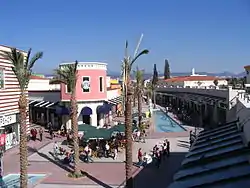

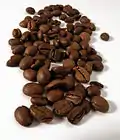
_-_1.jpg.webp)